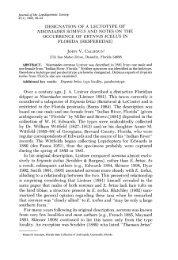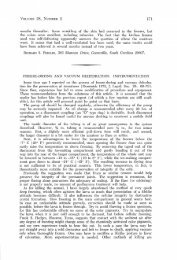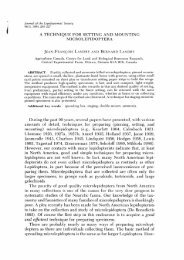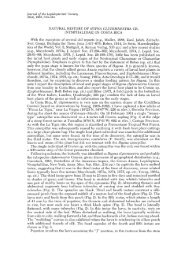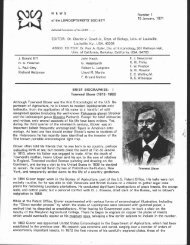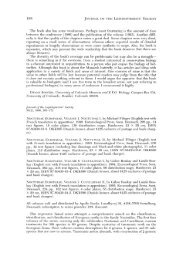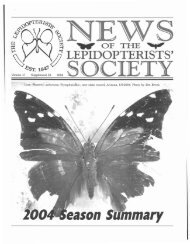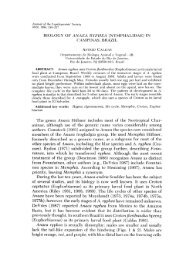HOW TO MAKE REGIONAL LISTS OF BUTTERFLIES - Yale University
HOW TO MAKE REGIONAL LISTS OF BUTTERFLIES - Yale University
HOW TO MAKE REGIONAL LISTS OF BUTTERFLIES - Yale University
You also want an ePaper? Increase the reach of your titles
YUMPU automatically turns print PDFs into web optimized ePapers that Google loves.
VOLUME 33, NUMBER 4 225limiting the area to their own personnel. Sometimes, however, theyare only too happy to let you use the area, if you ask first, explain youraims, and don't mistreat the area.Private lands often have ideal places for such a project. Again, askthe owner and get his permission first. In recent years the land ownerhas gotten much more hard-nosed about strangers on his land. He orhis neighbors may have been victimized by careless or maliciouscampers, wanton vandals, drunken or stupid hunters, and who knowswhat else: his attitudes can hardly be faulted. In most cases, however,if you can satisfy him that you are serious, and that you will not tramplehis crops or leave trash behind you, he will willingly let you usehis property.In using any land ordinary courtesy is necessary. Do not litter; donot walk on crop plants; do not leave gates open if they were closed,and vice versa, follow paths as much as possible. If the area is alreadyin use by other researchers, familiarize yourself with what they aredoing and be careful not to interfere with their projects. Respect fullyany ground rules that may be in force. Regardless of who owns theland, it is good public relations to keep them informed, if only in ageneral way, of your progress. If you find a rarity, or make an importantor unusual discovery, tell them. Land owners or managers liketo hear that their place is "special." And when you publish, acknowledgethem by name, and give them a reprint of your paper.MethodsI assume that you have chosen an area, and that you will be makingperiodic visits, perhaps once a week or so. As in state lists, I keep twobooks of records:(1) Log book. This need not be loose-leaf, as it is strictly chronological:on each visit enter date, time you begin fieldwork, and timeyou finish. Record weather data (temperature, cloud cover, wind; andany important changes during your visit). List the species you take orobserve in the area, where you see them, how common they are, theircondition: these three matters are discussed more fully below. Recordany special observations, such as territorial behavior (time of day,territorial activity, size of territories, and so on), predator attacks (details),mating or courtship behavior (nature of activity, time, sex of theflying partner in copulating pairs, and so on), unusual numbers, ovipositionrecords, flowers serving as adult food, etc.(2) Species book. This should be loose-leaf, to allow additions. Aseparate sheet (or more) for each species, entering dates, particularplaces, and other information from your log. It will be repetitive, certainly,but this accumulation of data is the core of your whole project.




